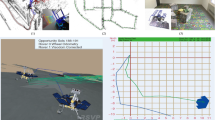Abstract
Camera calibration is a crucial step in 3D reconstruction. To improve the reconstruction accuracy, we propose a calibration method for the paracatadioptric camera based on the projective properties of spheres. The starting point of the method is to consider the three great circles that are parallel to the projection of the sphere onto the unit viewing sphere in the imaging model of the paracatadioptric camera. The absolute conic is determined from the orthogonal vanishing points obtained from the intersections of the projections of the three great circles on the image plane. Then, the intrinsic parameters are obtained from the algebraic constraints on the image of the absolute conic. Compared with results obtained by Zhao’s, Yu’s and Li′s methods, 3D reconstruction using our method appears more accurate.














Similar content being viewed by others
References
Agrawal M, Davis LS (2003) Camera calibration using spheres: asemi-definite programming approach, in Proceedings of the IEEE International Conference on Computer Vision (2003), pp. 782–789
Agrawal M, Davis LS (2007) Complete camera calibration using spheres: a dual-space approach. Anal. Int Math J Anal Appl 34(3):257–282
Baker S, Nayar SK (1999) A theory of single-viewpoint catadioptricimage formation. Int J Comput Vis 35(2):175–196
Barreto JP, Araujo H (2003) Paracatadioptric camera calibration using lines, in Proceedings of the IEEE International Conference on Computer Vision, pp. 1–7
Duan H, Wu Y (2011) Paracatadioptric camera calibration using sphere images, in Processing IEEE International Conference on Image, pp. 641–643
Duan H, Wu Y (2012) A calibration method for paracatadioptric camera from sphere images. Pattern Recogn Lett 33(6):677–684
Duan F, Wu F, Zhou M, Deng X, Tian Y (2012) Calibrating effective focal length for central catadioptric cameras using one space line. Pattern Recogn Lett 33(5):646–653
Duan HX, Wu YH, Song L, Wang J, Liu N (2014) Properties of central catadioptric circle images and camera calibration,in Springer International Conference on Rough Sets and Knowledge Technology, pp. 229–240
Duan HX, Wu YH, Song L, Wang J (2019) Fitting a cluster of line images under central catadioptric camera. Cluster Computer 22:781–793
Geyer C, Daniilidis K (2000) Equivalence of catadioptric projectionsand mappings of the sphere, in Proceedings of the IEEE Work.shop on Omnidirectional Vision (2000), pp. 91–96
Geyer C, Daniilidis K (2001) Catadioptric projective geometry. Int J Comput Vis 45(3):223–243
Geyer C, Daniilidis K (2002) Paracatadioptric camera calibration. IEEE Trans Pattern Anal Mach Intell 24(5):687–695
Jia J, Jiang G, Cheng-Ke WU (2010) Geometric interpretations and applications of the extrinsic parameters derived from the cameracalibration based on spheres. IEEE Trans Pattern Anal Mach Intell 23(2):160–164
Li YZ, Zhao Y (2017) Calibration of paracatadioptric camera by projection imaging of single sphere. Appl Opt 10:2230–2240
Li YZ, Zhao Y, Zheng BH (2018) Calibrating a paracatadioptric camera by the property of the polar of a point at infinity with respect to a circle. Applied Optics 57(15):4345–4352
lllingworth J, Kittler J (1988) A survey of the Hough transform. Comput. Vis. Graph. Image Process 43:765–768
Marr D (1982) Vision. W. H, Freeman and Company (San Fransisco
Micusik B, Pajdla T (2004) Para-catadioptric camera auto-calibration from epipolar geometry, in Proceedings of the Asian Conference on Computer Vision (AFCV), pp. 748–753
Teramoto H, Xu G (2002) Camera calibration by a single image of balls: from conics to the absolute conic, in Proceedings of the5th Asian Conference on Computer Vision (2002), pp. 499–506
Wang YL, Zhao Y (2015) Intricsic parameter determination of a paracatadioptric camera by the intersection of two sphere projections. Optical Society of America A 32(1):2201–2209
Wang YL, Zhao Y (2019) Paracatadioptric camera calibration based on the projecting relationship of the relative position between two spheres. Springer Multimedia Tools and Applications 78:12223–12249
Wang SW, Zhao Y, You J (2020) Calibration of paracatadioptric cameras based on sphere images and pole-polar relationship. OSA Continuum 3(4):993–1012
Wu YH, Hu ZY (2005) Geometric invariants and applications under catadioptric camera model, in Proceedings of the IEEE International Conference on Computer Vision pp.1547–1554.
Xu G, Hao Z, Li X, Su J, Liu H, Zhang X (2016) Calibration method of the laser plane equation for vision measurement adoptingobjective function of uniform horizontal height of feature points. Opt Rev 23(1):33–39
Yang S, Liu M, Song J, Yin S, Guo Y, Ren Y, Zhu J (2017) Projector calibration method based on stereo vision system. Opt Rev 24(5):727–733
Ying X, Hu Z (2004) Spherical objects based motion estimation forcatadioptric cameras, in Proceedings of the IEEE InternationalConference on Pattern Recognition (2004), pp. 231–234
Ying X, Hu Z (2004) Catadioptric camera calibration using geometric invariants. IEEE Trans Pattern Anal Mach Intell 26(10):1260–1271
Ying X, Zha H (2008) Identical projective geometric properties of central catadioptric line images and sphere images with applications to calibration. Int J Comput Vis 78(1):89–105
Zhang X, Ji X (2012) An improved Harris corner detection algorithm for noised images, in International Conference on Materials Science and Information Technology, pp. 6151–6156
Zhang H, Zhang G, Wong KY (2005) Camera calibration with spheres: linear approaches, in Proceedings of the IEEE International Conference on Image Processing, pp. 1150–1153
Zhang H, Wong KY, Zhang G (2007) Camera calibration from images of spheres. IEEE Trans Pattern Anal Mach Intell 29(3):1499–1502
Zhang L, Du X, Hu JL (2010) Using concurrent lines in central catadioptric camera calibration. Zhejiang University Science C 12(3):239–249
Zhao Y, Gu WJ (2016) Method to solve intrinsic geometric parameters of a paracatadioptric camera using 3D lines. Optick 127(5):2325–2330
Zhao Y, Yu XJ (2019) Paracatadioptric camera calibration using sphere iamges and common self-polar triangles. Opt Rev 26(11):1–12
Funding
National Natural Science Foundation of China (62063034).
Author information
Authors and Affiliations
Corresponding author
Additional information
Publisher’s note
Springer Nature remains neutral with regard to jurisdictional claims in published maps and institutional affiliations.
Rights and permissions
About this article
Cite this article
Yang, R., Zhang, J. A calibration method for paracatadioptric cameras based on circular sections. Multimed Tools Appl (2022). https://doi.org/10.1007/s11042-022-12918-9
Received:
Revised:
Accepted:
Published:
DOI: https://doi.org/10.1007/s11042-022-12918-9




